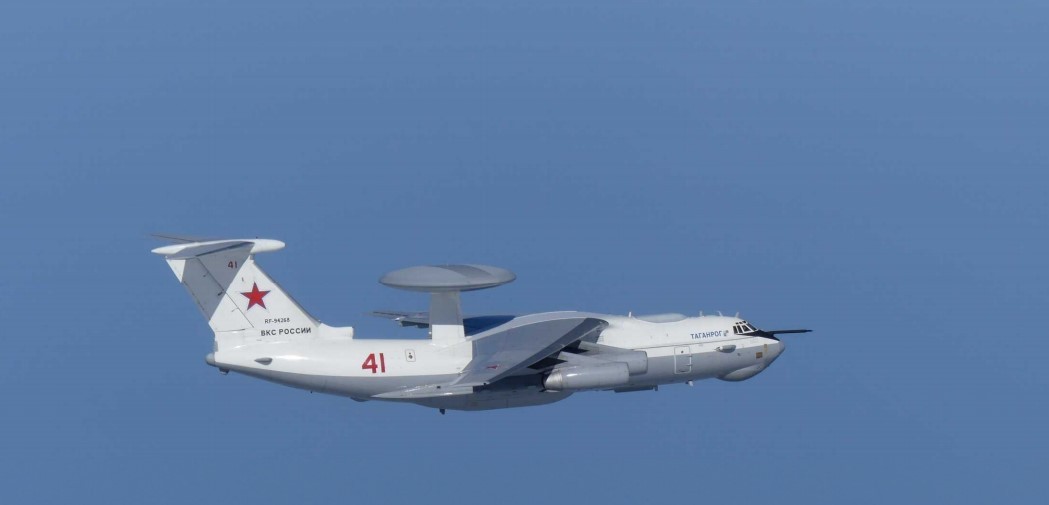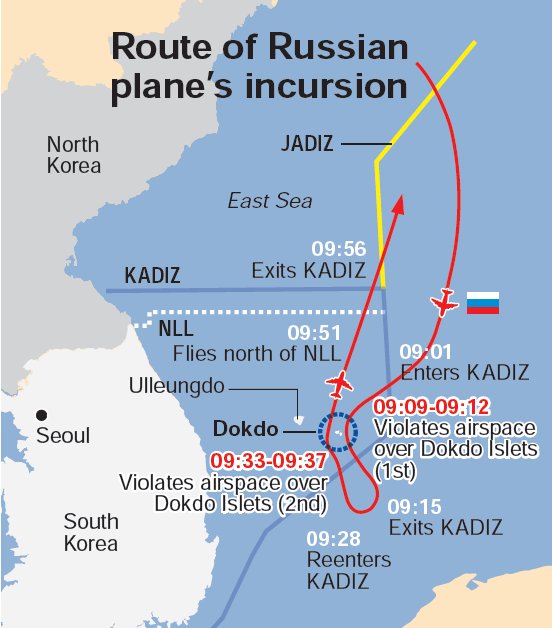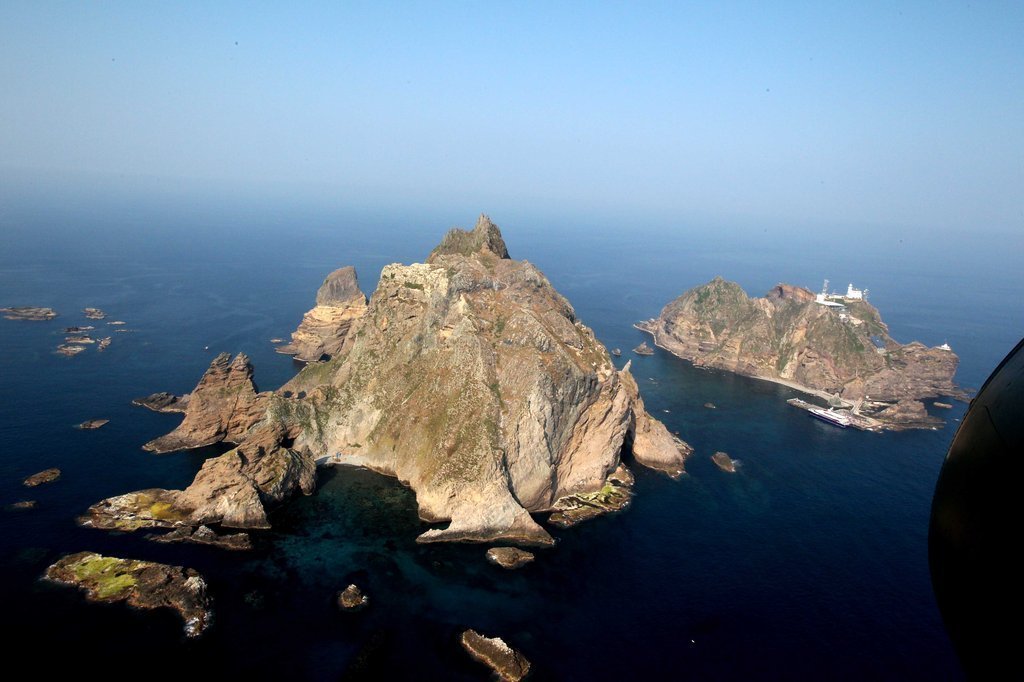KADIZ emerges as potential flashpoint?
Defense Ministry slams Japan’s claims over Dokdo
By Jo He-rimPublished : July 24, 2019 - 16:47
The Korea Air Defense Identification Zone in the East Sea has come under the spotlight after warplanes from four countries became tangled in the area Tuesday.
Two Russian TU-95 strategic bombers and two Chinese H-6 strategic bombers entered the KADIZ without prior notice in the early hours of Tuesday. A Russian A-50 -- an early warning and control aircraft -- further trespassed into South Korea’s airspace above the Dokdo Islets, twice, prompting the Air Force to fire over 300 warning shots.
The Korean government immediately lodged complaints with China and Russia. But both countries denied any violation, saying they were conducting a joint air patrolling mission in neutral waters.
Two Russian TU-95 strategic bombers and two Chinese H-6 strategic bombers entered the KADIZ without prior notice in the early hours of Tuesday. A Russian A-50 -- an early warning and control aircraft -- further trespassed into South Korea’s airspace above the Dokdo Islets, twice, prompting the Air Force to fire over 300 warning shots.
The Korean government immediately lodged complaints with China and Russia. But both countries denied any violation, saying they were conducting a joint air patrolling mission in neutral waters.

Following the incident, China’s Foreign Ministry said that the KADIZ is not “territorial airspace,” and that “all countries enjoy freedom of movement there.”
Beijing and Moscow also said their sorties on Tuesday were part of the first joint air patrol mission using long-range aircrafts in the Asia-Pacific region, and they were not directed against any other third state.
Adding to that, Russia also objected to the Korean Air Force’s warning shots, saying they “conducted unprofessional maneuvers.”
The disputed concept of air defense identification zone is an area declared by a country, where it can demand identification and information regarding the flight of foreign aircrafts. This is so that aircrafts approaching its territorial airspace can be detected early, preventing infiltration and accidental clashes.
But, unlike territorial sky, over which a country has sovereignty under international law, the ADIZ is not legally guaranteed to the states.
“It is international convention for one to obtain approval from the country in charge of the air defense zone, before entering,” a ministry official told The Korea Herald. “As neighboring countries, even we, South Korea and Japan, do not cross into each other’s zones.”

China was seen scrambling jets and demanding identification in January, when a foreign aircraft entered CADIZ in the East China Sea, which it unilaterally declared.
At the time of Tuesday’s incident, the Korean Air Force dispatched dozens of fighter jets, including the F-15K and KF-16, and sent more than 25 warning signals to both the Chinese and Russian aircrafts. But they did not respond to a single call, according to Seoul’s Joint Chiefs of Staff.
It is not the first time that Chinese and Russian warplanes have violated the KADIZ. According to Seoul’s Defense Ministry, there have been a total of 38 cases of foreign military aircrafts trespassing the KADIZ this year -- all from the two countries. China entered the KADIZ 25 times, while Russia came in 14 times this year.
While the intentions of the China-Russia military exercise in the East Sea is not clear, one of the reasons for the trespassing could be the Russian bombers, according to experts.
“The TU-59 is a long-range strategic bomber, and it needs a large area to train. So flying far down to the East Sea appears to be a good route,” a ministry official, an experienced pilot, told The Korea Herald.
“They were also running a package exercise, with the A-50 commander and control aircraft supporting the bombers.”
With such joint military exercises likely to become regular and Russia and China frequently neglecting air defense zones of other countries, the potential for a clash is real.
“Such patrols will become a regular feature under a new agreement soon to be signed between Moscow and Beijing,” Dmitri Trenin, the director of the Carnegie Moscow Centre and a former colonel in the Russian army said on Twitter. “Russo-Chinese entente grows thicker.”

Dokdo Islets inside KADIZ
Another controversy sparked over KADIZ when Japan lodged a complaint against the Korean Air Force taking actions against the Russian A-50 that intruded into the airspace above Dokdo Islets.
Referring to the incident, Japan’s Chief Cabinet Secretary Yoshihide Suga claimed Tuesday that the Russian warplane violated its territory. Tokyo said it also lodged a protest with Seoul over the incident.
On Wednesday, Korea’s Defense Ministry dismissed Japan’s renewed territorial claim over the Dokdo Islets.
“Japan’s claim does not deserve any consideration,” the Defense Ministry said in a press release. “As Dokdo is our inherent territory historically, geographically and by international law, we make it clear that we will sternly respond to any outside intrusion over Dokdo.”
The Dokdo Islets, located some 87 kilometers away from Korea’s Ulleung Island, is located inside KADIZ. Japan claims territorial sovereignty over the islets, calling it Takeshima.
Experts point that Japan’s latest claim is flawed, as its ADIZ does not include the Dokdo Islets.
“It is obviously normal for countries to declare the ADIZ to include their territorial lands. JADIZ is not set that way, and Japanese warplanes never enter the KADIZ,” a ministry official told The Korea Herald.
Japan also said it had scrambled fighter jets when the Russian and Chinese warplanes entered its JADIZ. However, its aircrafts did not come into KADIZ to take action against the Russian A-50 when it flew into the airspace above the islets.
By Jo He-rim (herim@heraldcorp.com)







![[KH Explains] How should Korea adjust its trade defenses against Chinese EVs?](http://res.heraldm.com/phpwas/restmb_idxmake.php?idx=644&simg=/content/image/2024/04/15/20240415050562_0.jpg&u=20240415144419)











![[Today’s K-pop] Stray Kids to return soon: report](http://res.heraldm.com/phpwas/restmb_idxmake.php?idx=642&simg=/content/image/2024/04/16/20240416050713_0.jpg&u=)